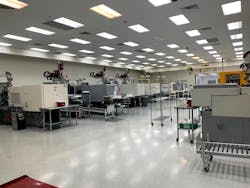Trademark Plastics Adapts to Market Changes with ERP
Riverside, Calif.-based Trademark Plastics Inc. (TPI) is a manufacturer of injection-molded parts. With eight of the world’s top 30 medical device manufacturers among its customers, 85% of TPI’s business comes from the creation of medical components for these customers.
With COVID-19 roiling healthcare operations for nearly two years, adjusting operations to the quickly changing realities facing the medical community has proved to be a constantly moving goal.
Data from the machines in TPI’s facility are fed into the DelmiaWorks manufacturing enterprise resource planning (ERP) system (formerly known as IQMS, which was acquired by Dassault Systèmes in 2019). The information in the ERP software is then used to provide real-time alerts as well as generate nearly 20 different reports in SAP Crystal Reports (which provide detailed data analyses). Data from TPI’s SolidWorks computer-aided design (CAD) software creates the bills of material (BOMs) used by DelmiaWorks system to track materials and the status of each project.
“Everything is connected here at Trademark, from the material to miscellaneous items to robots, injection molding, and machine information, and it’s all located in DelmiaWorks,” says Bryan Barrera, chief operating officer at TPI.
Problem identification
To quickly identify potential issues during production, TPI uses real-time monitoring displays on the shop floor. Color-coding helps employees see whether production is running efficiently (green), running faster than planned (black), or deviating from set parameters (red).
“The system can tell you, for example, if you’re scheduled to produce 100 million components per day and your costs, and it’s going to let you know in real time whether or not you’re hitting your goals,” says David Carty, chief executive officer at TPI. “Also, when you see a red light pop up, possibly with some audio, you can go to a technician right then to troubleshoot the issue; whereas in the past, it might have been left alone for a couple hours, increasing the scrap ratio.”
“If our scrap report shows that we have a splay issue, the engineers can check if there's moisture in the material. If there is a tooling issue, the ERP system will say it needs repair. Burning material, flash, splay, these are all items tracked in a single scrap report,” Barrera says.
Also, because production data is shared with the ERP system’s customer relationship management (CRM) module, an alert will pop up if there is a delay in production so that TPI can advise the customer early in the process.
“We can say we’re a great supplier [because] with the DelmiaWorks we’re able to show customers and prospects the reports with our metrics. In our case, we’ve had zero returns for the last few months,” Barrera notes. “But if there was a return, we could show them how, for instance, a non-critical dimension was not caught. Having the data for these discussions really helps us out."
Several times throughout the year, TPI is also required to complete audits on behalf of ISO or MedAccred. These organizations want to understand how the manufacturer tracks its metrics, how the quality management system is set up, and how everything is captured and integrated. The company can track and report on much of the data using the ERP system.
Improved customer interaction
TPI also has realized significant efficiencies from using the ERP system to automate its quoting, expanding from hundreds to thousands of quotes without having to increase personnel. Equally important is the strategic advantage that combining automated quoting with production data in the ERP software has provided in creating win-win scenarios for the manufacturer and its customers—enabling TPI to sell more while offering customers better pricing.
“For example, if we have an order for 1,000 parts and we're able to manufacture 1,100 parts right then, we’ll produce the extra 100 parts, update the quote, and send it to the customer, perhaps giving them a price break,” Barrera explains. “Usually, they’ll accept the offer.”
Alternatively, Barrera notes, “Sometimes the customer reaching out to us doesn’t even know they have a price break, but we’ll reach out to the material manufacturer and get five prices with breaks for 100 pounds, 500 pounds, 1,000 pounds, etc., and put those in the quoting module. Then we can literally just look at the quoting screen and tell the customer how much they’re saving based off the price breaks.”
A third scenario is when the team gets an automated notification that demand for a product is slowing. If the product in question is a highly profitable one for the company, TPI can use that insight to offer the customer a 5% discount as an incentive to purchase more.
About the Author
David Greenfield, editor in chief
Editor in Chief

Leaders relevant to this article:


